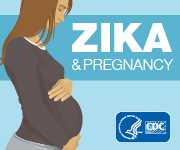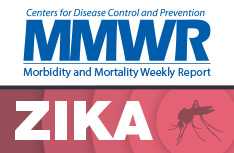Top 10 Zika Response Planning Tips: Brief Information for State, Tribal, Local, and Territorial Health Officials
Background
In December 2015, Puerto Rico, a U.S. territory, reported its first confirmed case of Zika virus disease.
Currently, Zika outbreaks are occurring in many countries and territories. Local mosquito-borne Zika virus transmission has also been reported in the continental United States. CDC continues to evaluate cases of Zika transmission in the United States and U.S. territories and updates guidance as new information becomes available.
In May 2015, the Pan American Health Organization (PAHO) issued an alert regarding the first confirmed case of Zika virus infection in Brazil. The outbreak in Brazil coincided with increased reports of Guillain-Barré syndrome (GBS) and pregnant women giving birth to babies with birth defects. Recently, CDC scientists announced that there is now enough evidence to conclude that Zika virus infection during pregnancy is a cause of microcephaly and other severe fetal brain defects.
Local, state, and territorial responses to Zika cases or an outbreak will differ in jurisdictions where Aedes species mosquitoes (A. aegypti and A. albopictus) are endemic, and, therefore, local mosquito populations could become infected with Zika virus. All locations will likely have travel-associated cases, and there is priority need for laboratory testing capabilities, enhanced epidemiology, and surveillance systems, and support for pregnant women and families with a child born with microcephaly or other birth defects linked to Zika virus infection. Following are resources CDC has developed to help state, local, and territorial public health officials prepare for potential Zika virus cases.
1) Vector Control and Surveillance
Applicable in all locations where Aedes aegypti or Aedes albopictus mosquitoes are endemic.
Goal
To target vector control programs in priority areas/at-risk populations to suppress Zika virus transmission if local cases or an outbreak is detected.
Action Steps
- Establish a communication network with vector control/surveillance partners.
- Develop and implement a plan to establish or enhance local vector surveillance and control, especially in jurisdictions where Aedes aegypti and Aedes albopictus are endemic.
- Identify, and train if necessary, partners to fill gaps in vector control coverage in the event local mosquitoes become infected with Zika virus.
- Educate communities on how to reduce vector populations through source reduction.
- Educate communities on how to protect themselves using personal protection and primary mosquito prevention methods.
- Provide vector guidance and vector control services to pregnant women in high-risk areas.
Resources
2) Public Health Surveillance and Epidemiological Investigation
Goals
To ensure adequate diagnosis and reporting of Zika virus cases; to monitor epidemiologic trends in distribution, transmission, and severity; to direct prevention and control efforts; and to identify cases that require follow up or intervention.
Action Steps
- Determine if systems and procedures are in place to identify potential or confirmed Zika cases:
- through symptomatic infections
- in pregnant women
- associated with reproductive or congenital outcomes, including microcephaly
- associated with Guillain-Barré syndrome
- associated with blood transfusions
- associated with sexual transmission
- Ensure investigating officials and clinicians have the latest case definitions developed with the assistance of the Council of State and Territorial Epidemiologists.
- Ensure clinicians are aware that, as an arboviral disease, Zika is a nationally notifiable condition in the National Notifiable Disease Surveillance System.
Resources
3) Laboratory Testing and Support Services
Goal
To ensure state and territorial health departments have the support needed to adequately test specimens from suspect Zika cases.
Action Steps
- Determine which laboratories in the jurisdiction are capable of conducting RNA nucleic acid testing (NAT) or IgM antibody ELISA for Zika virus infection.
- Assess routine and surge capacity of laboratories to aid in setting priorities for specimen testing.
- Communicate with healthcare providers about how to submit specimens through the state health department.
- Establish a point of contact for health care providers who have questions regarding testing services and the interpretation of results of tests for Zika virus infection.
Resources
4) Prevention of Sexually Transmitted Zika Virus Infections
Goal
To reduce the risk of sexually transmitted Zika virus by providing guidance to the public regarding the risks and to clinicians so they may counsel their patients.
Action Steps
- Educate the public and clinicians so they are aware of the risks of sexual transmission of the Zika virus so that the public, especially pregnant women, follow guidelines to prevent transmission and further spread of the virus.
Resources
5) Prevention of Blood Transfusion–transmitted Zika Virus Infections
Goal
To reduce the risk of transfusion-transmitted Zika virus during a local or more widespread outbreak in areas with active transmission.
Action Steps
- Coordinate with local and state epidemiology and surveillance partners to identify the support needed to investigate Zika virus infections suspected to be associated with blood products or transfusions in collaboration with local blood centers and transfusing healthcare facilities.
- Identify local blood centers within endemic areas to ensure that blood products collected are tested for the Zika virus, subjected to pathogen-reduction technology, or come from sources where Zika infection is not present.
Resources
6) Maternal and Child Health Surveillance and Response
Goal
To prevent Zika virus infection during pregnancy, monitor pregnant women with suspected or confirmed Zika virus infection, and follow up to track adverse pregnancy and infant outcomes.
Action Steps
- Determine if a state-level pregnancy registry reporting system is in place to actively monitor pregnant women with suspected or confirmed Zika infection.
- Incorporate information from this system into other systems that monitor pregnant women and infants/children.
Work with CDC to engage in U.S. pregnancy registry. - Ensure training and educational materials from CDC are appropriately augmented with information on state/territorial requirements and distributed to healthcare providers to:
- Reach healthcare providers who are counseling patients on how to reduce their risk of sexual transmission of the Zika virus and reduce unintended pregnancies through provision of effective contraception.
- Advise patients, especially pregnant women and women trying to become pregnant, on how to reduce mosquito exposure.
- Ensure obstetric providers increase screening for symptoms of Zika and adhere to the CDC guidelines for monitoring pregnant women in regions with local transmission.
- Incorporate information from this system into other systems that monitor pregnant women and infants/children.
Resources
- Clinical Guidance for Healthcare Providers Caring for Pregnant Women
- Clinical Guidance for Healthcare Providers Caring for Infants & Children
- CDC’s Health Alert Network (HAN)
- For Healthcare Providers – Training
- Clinical Guidance for Healthcare Providers for Prevention of Sexual Transmission of Zika Virus
- MMWR Zika Reports
7) Rapid Birth Defects Monitoring and Follow-up
Goal
To ensure rapid detection of microcephaly, other major birth defects, and other disabilities that might be associated with Zika virus infection and to plan for adequate services for these children and their families
Action Steps
- For those states/territories with a state birth defects surveillance program, ensure healthcare providers have information regarding reporting requirements and infrastructure.
- Ensure training and educational materials from CDC are appropriately augmented with state/territorial requirements and distributed to pediatric providers so that they can evaluate infants with possible congenital Zika virus infection.
- Determine if projected needs (medical and support) for families with a child with microcephaly or another major birth defect have been assessed and planned for and if there is a system in place with the capacity to adequately address those needs.
Resources
8) Travel Health News
Goal
To ensure travelers to areas with locally transmitted Zika virus receive appropriate information regarding risks and protection measures.
Action Steps
- Disseminate travel notices designed to inform travelers and clinicians about the risks for contracting Zika infection related to specific destinations and provide prevention recommendations.
Resources
9) Clinician Outreach and Communication
Goal
To inform healthcare providers on the risks, recognition, diagnosis, reporting, clinical management, outcomes, and prevention of Zika virus infections.
Action Steps
- Review updates to Zika material, including clinical care guidelines, and augment the material to meet the needs/regulations within the jurisdiction.
- Identify the most appropriate and functional channels to share information with healthcare providers (e.g., Health Alert Network, webinars).
Resources
10) Risk Communication/Community Education
Goal
To inform the public about Zika virus and related birth defects or illnesses, especially microcephaly and other harmful effects to pregnant women and their fetuses.
Action Steps
- Develop communication messages, products, and programs with key partners and stakeholders to harmonize response for people traveling to or living in areas of higher risk of Zika transmission.
- Identify primary communication outlets for areas of high risk populations (e.g., radio, television) and potential for using those channels to communicate messaging.
- Use the CDC Joint Information Center (JIC) key messages document, CDC Zika website, and other CDC resources, along with local resources, as needed, to prepare messaging materials.
- Work with CDC’s JIC on development of printed, radio, and visual materials as needed.
- Identify local vendors for translation (as necessary), printing, signage, audiovisual/public service announcement development and determine what is required (funding, contract approval) to use these resources for message and product dissemination.
Resources
- Page last reviewed: November 17, 2016
- Page last updated: November 17, 2016
- Content source:





 ShareCompartir
ShareCompartir